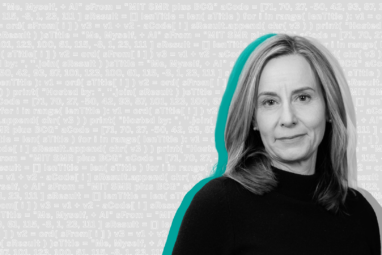Topics
Even as the corporate benefits of diversity and inclusion have become widely understood, and even as legions of companies appear to be embracing the mandate to increase the diversity of their workforces from the front lines to the C-suite, actual progress continues to disappoint.
Moving the needle meaningfully and permanently requires nothing less than the full commitment of the CEO. At least, that is the position of this week’s guest, Tim Ryan, the U.S. chairman of PwC. Ryan also helped launch CEO Action for Diversity & Inclusion, an initiative that includes some 900 signatories. In this week’s episode, he offers a frank assessment of the scope of the challenge and points to some specific and replicable practices that are actually working. Among his insights are these three big points:
- Overcoming the challenges to diversity and inclusion cannot be addressed as a company problem — it is the responsibility of the collective business community.
- Dialogue and education are the essential building blocks of cultures that will embrace and sustain commitments to diversity.
- CEOs and their boards are in this together: They must prioritize and build accountability for actual outcomes.
For Further Reading
Subscribe to Three Big Points on Apple Podcasts, Spotify, or Google Podcasts via the Subscribe dropdown menu above.
Transcript
Tim Ryan: The reality is, diversity inclusion is not only our society’s biggest challenge, it’s our society’s biggest opportunity. If we figure this out, the economic prosperity that we will all achieve, in the sense of fairness and decency across all of our people in our communities, will be amazing.
Paul Michelman: I’m Paul Michelman, and this is MIT Sloan Management Review’s Three Big Points. Each week, we take on one topic that leaders need to be on top of right now and leave you with three key takeaways for you and your organization.
By now, we know from the data and the studies out there that creating a more diverse, inclusive workplace is not only good for people — it’s good for companies, too. Still, in many places — in too many places — diversity efforts are failing to get results, and we see the status quo continuing to hold strong. Today’s guest says that while progress has been slow, there is real reason for hope, and there is evidence that points to a better way.
Tim Ryan: For a decade and a half in corporate America, we’ve been at diversity inclusion in one way, shape or form, or another. When I look at it, I think the heart is in the right place. I think what we’re learning is root cause analysis as to what’s really driving a lack of progress in many cases. [That’s] where we’re now just beginning to really learn.
Paul Michelman: That’s Tim Ryan, U.S. chairman and senior partner at PwC, and chair of CEO Action for Diversity & Inclusion. And Ryan says that within PwC, they are thinking differently about how to bring diversity to the forefront.
Tim Ryan: In the old days, many organizations went with targets. And those are admirable, and those are understandable. What we’re now learning is that one of the big root causes is understanding — like understanding where people come from, understanding what their experiences are, understanding at a very human level what the challenges [are] that our different underrepresented minorities have.
Paul Michelman: The key, Ryan says, is learning to have the difficult conversations — and then figuring out a way to scale that behavior. PwC had its first daylong discussions on race in July 2016 — a decision that was driven from the top management at PwC and that came in the wake of several racially charged incidents that had taken place, including shootings of police officers in Dallas and a group of Somali Americans in Minneapolis.
Tim Ryan: We — me, as the senior partner — gave permission and set up a structure to have those conversations across the country. Over the course of that following year, we did more from the top down. By driving it from the top down, we gave permission. We started to develop a culture.
Paul Michelman: Driving culture from the top of one company was only half of the story, he says. Along with several other CEOs, Ryan launched CEO Action for Diversity & Inclusion to encourage a collective approach to boosting diversity, and that group now includes more than 900 CEOs, representing some 20 million workers in the U.S. And those leaders have held more and more sessions with their own employees to let people speak up.
Tim Ryan: We learned from a black professional what it’s like to be black at PwC from his perspective. He shares that he feels safe in a suit and tie, but when he’s going to a softball game in Central Park, and he’s leaving work in his shorts and cutoff T-shirt — he feels like eyes are looking at him in a different way, and he feels like people are thinking they feel unsafe, and that makes him feel uncomfortable. We learned what it’s like to be a working mother balancing a whole bunch of different aspects of life — balancing children and balancing work. And when we learn those things, we then become more empathetic, and that’s why this personal storytelling is so important. It’s equally important for the white male to be able to share how they feel — that they’re nervous about saying the wrong thing, they’re not sure how to help, they don’t want to be [presumptuous]. And by getting those feelings out — that’s how we’re beginning to make more progress.
Paul Michelman: As a CEO, Ryan is interacting with people both inside and outside of PwC on diversity and inclusion — at structured events, like the firm’s Days of Understanding, but also informally.
Tim Ryan: Where they’re at their best is when they meet somebody, and they hear a story — meaning, when they put their finger in the wound. When they get to experience it, both as someone who’s been treated poorly [or is] uncomfortable, or [as] someone that the other person reaches out to … then that level of understanding goes to the next level.
Paul Michelman: Having these conversations frequently not only drives better understanding, it also makes teams more ready to talk to each other when tragedy strikes.
Tim Ryan: In the fall of 2018, unfortunately, one of our black professionals was shot and killed in Dallas. It was tragic — he was eating cereal in his apartment, watching Thursday Night Football, when an off-duty Dallas police officer shot and killed him. What happened at PwC, immediately, was the discussion started happening all across the country from the bottom up. We had developed enough muscle where we knew what to do. Our people knew what to do.
Paul Michelman: Having conversations may sound simple enough, but embedding it into your culture is not an easy change to make. And of course, it’s not the only thing organizations should be doing.
Tim Ryan: We don’t have this all figured out. We’ve swung the bat a lot. We’ve missed a lot, and we’ve hit some, meaning we’ve had some things that have worked. Three years ago, we drove Days of Understanding from the top. And so I think as organizations start, it has to be top-down driven. The CEO gets the culture and determines the values of the firm, of the organization. Over time, those discussions then start to become more natural, but it takes years to develop.
Paul Michelman: Ryan himself faced early pushback from some of his peers in trying to make these changes.
Tim Ryan: Early on in my tenure as senior partner — which is our equivalent of CEO — just a month or so into my tenure, one of my closest friends, who [had] supported me throughout my career, he called me up, and he said, “Tim, you need to be careful. This is not what we elected you for” — meaning, we elected you for other things, like growing the business and whatnot.
And I talked to him, and I said (I won’t say what his name is. I’ll say it was Fred. His name was not Fred) — I said, “Fred, do me a favor. I promise I will listen. But go talk to some of our underrepresented minorities. Go sit with them. And then let’s talk.”
He called me back a couple of weeks later. “Tim,” he said, “I had no idea. No idea.” He said, “I get it.”
Paul Michelman: Now, this is all well and good, but conversations also need to lead to outcomes. One way of measuring that is how many women and people of color occupy positions of power at an organization.
Tim Ryan: We’ve asked all 900 companies to prepare and review with the board an annual diversity inclusion strategic plan — no different than you would have one for revenue growth, no different than you would have one for risk management or capital liquidity. And those diversity inclusion strategic plans should go through everything from recruiting, retention, pay gap, and, to your point, representation. Now, there’s some organizations that have invested in succession planning, some organizations that have aggressively sought people outside their organizations. They have more diversity at the board level and have more diversity in the C-suite, and that certainly has a positive effect on our employees.
Paul Michelman: Ryan notes that one reason PwC has such a diverse board today is because of the work his predecessor did in succession planning — spending years grooming people to move up into positions and to make sure the talent pool was both deep and diverse. And Ryan also argues that even in a time of crisis, like the coronavirus pandemic, it’s more important than ever to keep diversity efforts going and to keep growing them.
Tim Ryan: The strategy behind CEO Action and the reason that we did it — what we realized was, there are a lot of companies doing some amazing things, but what we needed was scale. We needed the ability to achieve a couple of things. No. 1, to show the world that the business community is taking this thing seriously. No. 2, a lot of companies are blessed with a lot of financial resources where they can invest in training, in programs in leadership development, in succession planning. And we needed a way to scale and share the best practices for all companies.
Paul Michelman: Now, on the CEO Action website, there are hundreds of best practices that people can look up and learn from, and then implement in their own organization.
Tim Ryan: The idea of getting 900 in the boat together — and we meet a couple of times a year, both virtually and physically — is we give them a chance to interact on this topic. And they get the ability to see where their peers really are, and most leave those sessions with a sense of “I thought I was doing good, but there’s a lot more I can do.”
Paul Michelman: That’s PwC’s Tim Ryan. And now, three big points about increasing diversity at organizations — from the top down and the bottom up.
Number one: Collaboration and action by the collective business community is key to diversity and inclusion progress.
Tim Ryan: The reality is, diversity and inclusion is not only our society’s biggest challenge, it’s our society’s biggest opportunity. If we figure this out, the economic prosperity that we will all achieve, in the sense of fairness and decency across all of our people in our communities, will be amazing. We can’t solve this by ourselves. If it’s PwC trying to compete and get another organization’s diverse talent, or an airline trying to get another airline’s, or a bank trying to get another bank’s, we’re missing the bigger point. If we come together, and we all solve this issue, we all prosper, and we do the right thing. And from my perspective, this is the biggest opportunity we have to drive even more economic prosperity in our country.
Paul Michelman: Number two: Dialogue is a critical element in fueling and driving education among employees.
Tim Ryan: One of the things that we know more now than we knew 10 years ago or even five years ago is, we’ve got to talk about this. We need to understand each other’s feelings. The first pledge of CEO Action, the first of the four pledges, is CEOs committing to make the workplace safe, and I mean truly safe, to talk about the important issues. And I’m absolutely convinced the more we all understand about each other and that we’re all humans — we’re not all men, we’re not all black, we’re not all women, but we’re people — the more understanding we’ll have and, from my perspective, the more opportunity we’ll have to get better.
Paul Michelman: And number three: CEOs and their boards should work together to prioritize and drive accountability.
Tim Ryan: CEOs need to go into their boards and not say that it’s a journey but treat it like any other business opportunity and say, “This is a big opportunity. Here’s what we’re going to do to go get it.” And boards play a huge role in making that happen. We need to make this a top priority because it’s the right thing to do, and it’s a massive opportunity for the country.
Paul Michelman: That’s this week’s Three Big Points. You can find us on Spotify, Apple Podcasts, Google Podcasts, Stitcher, and wherever fine podcasts are streamed. If you’d like to support our show, please post a rating or a review on whatever podcast platform you prefer.
Three Big Points is produced by Mary Dooe. Music by Matt Reed. Marketing and audience development by Desiree Barry. Our coordinating producer is Mackenzie Wise.





